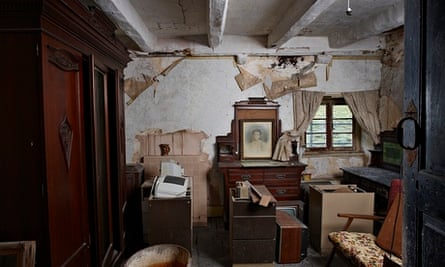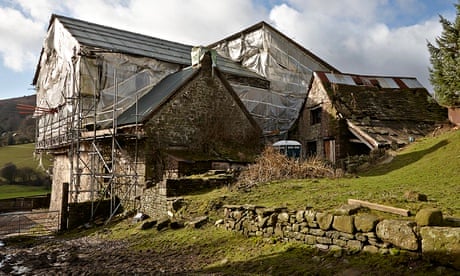Rainwater pours through the stone roof tiles on to 15th-century carved timbers, and in heavy downpours a river runs down the hill behind the house, in through the back door, along the main passageway and out through the front door.
The manor house in the Black Mountains in Wales was built around 1480, and despite its decrepit appearance the last owners, farming brothers Trevor and Lyndon Powell, only moved out in February, making Llwyn Celyn one of the longest continuously occupied houses in Britain.
The last serious modernisation was in the 1700s, and apart from some Victorian wallpaper, and electricity in the corner of the building occupied by the Powells, it has scarcely been touched since.
The Landmark Trust charity, which restores historic properties ranging from vintage pig sties to medieval castles and rents them out as holiday homes, is now gathering courage and funds to tackle the building, cheered by a £32,000 grant from the Heritage Lottery Fund to start planning the work, and by the probability of further lottery funding next year.
"It is a thrilling building but absolutely terrifying," said Anna Keay, director of the trust. "The house is also a mystery. It is an absolutely sensationally good building, obviously for some top-notch customer, but we still don't know who it was built for. It must be significant that it was built at the edge of the Llanthony estate lands just when the priory was taken over by the dynamic Henry Deane, a future archbishop of Canterbury.
"We hope to find out through a community archaeology and research programme whether it was built for him or his distinguished visitors. I really look forward to unravelling the history of this house and I'm convinced we can do it."

The magnificent but decaying house has been a headache for generations of tenants, and to officialdom since a man with a clipboard appeared in the 1950s and penetrated beyond the fringe of barns and outbuildings that are a mere 300 years old.
The inspector from the Ministry of Works found an almost unchanged medieval house complete with superb-quality carved doorframes and panelling, and it was promptly listed Grade I. For many years it has been one of the most important buildings on the Welsh register of historic structures at risk. It was propped with scaffolding as an emergency measure more than a decade ago.
The Landmark Trust bought the property from the Powells more than two years ago with grants from Cadw and the National Heritage Memorial Fund. The brothers, who were born in the manor, have now moved into a brand new house but will continue to farm the land.
As well as letting out the main house, the trust plans to create a permanent display on its history in one of the outbuildings, and a bunk house and space for community use in another.
"The Powells have moved into the most modern house you could possibly imagine, with central heating controlled by WiFi, a total contrast from their own home – the contrast is extreme, but they love it," Keay said. "It's a very happy outcome for everyone."
